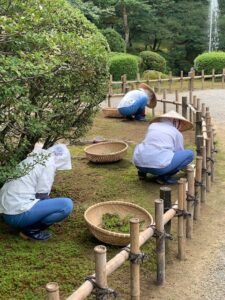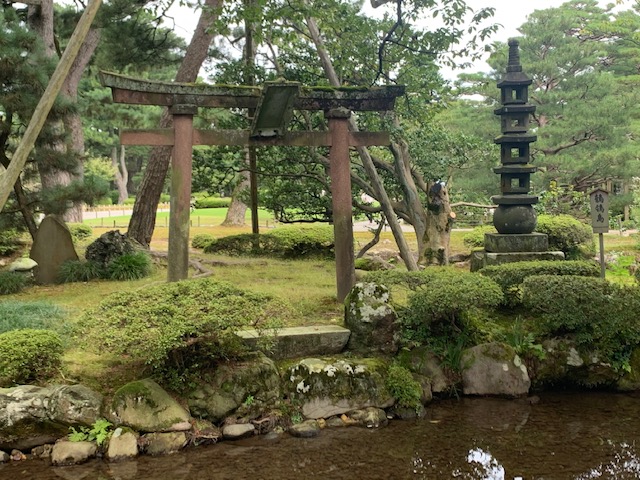After visiting the castle, I passed over the bridge to Kenrokuen, a stroll garden laid out for the feudal lords of the early seventeenth century. I had rarely visited it when I lived nearby, put off by the countless tour groups listening to loudspeakers announce that the grounds are noted for tranquility. And if that were not enough, there were school excursions and shouts of ‘Harro’, or if particularly brave, ’Harro, how are you? I am fine, thank you.’
Now however in a time of Covid there was time to stop and stare, time to take in all the beauty. It was as if I was seeing the garden for the very first time, with ability to appreciate. Before me lay an organic museum: rambling root and twisted bough; an awe-inspiring boulder; a tree trunk colonised by moss; 10,000 irises set along a rippling stream; the vigour of cedar trees; the elegant stone lantern adopted as symbol of the city.
When Basho visited on his long distance walk, he spent ten days in Kanazawa meeting with dignitaries and taking part in haiku gatherings. He may have been a wandering poet, but he was no solitary soul. It was late summer, and a haiku he wrote tells of the lingering heat.
Bright red sun
unrelenting, merciless –
yet an autumn breeze
Near a monument celebrating Basho’s visit stands a larger-than-life sculpture of Yamato Takeru, mythological hero of Kojiki (712). It was put up in the nineteenth century to commemorate soldiers killed fighting ‘the last samurai’, Saigo Takamori. While I was looking at the puffed cheeks of the statue, a man approached me and asked in Japanese, ‘Don’t you think it’s kirei?’ (Kirei can mean clean or beautiful, significant for Japanese aesthetics.) ‘It is made with a bird-repellent,’ continued my interlocutor, ‘which is why pigeons do not sit [or shit] on his head.’
As we walked, I realised the would-be guide was glad to have found a solitary gaijin with whom to share his love of the garden. ’You see the cherry grove,’ he said, ‘there are 420 trees and 40 different types.’ It was impressive, but I was already punch drunk with facts and figures and fauna, so I invited him to join me for a green tea on the veranda of an ancient teahouse. Before us was a pond with the oldest fountain in Japan, and we sat together listening to the sound of falling water. Like the carp, we were immersed in the moment.
To one side, three middle-aged women in traditional gardening gear were meticulously clearing away dead leaves from behind bushes, and it dawned on me that the garden had been maintained in this way for four hundred years. The pursuit of beauty, awareness of transience, the seasonal round, attention to detail, the cultivation of tradition, harmony with nature – it was all here, compressed into a garden, and it was in Kanazawa that I first awoke to the aesthetics. And the aesthetics, I later came to realise, are virtually synonymous with the ethics.




Leave a Reply